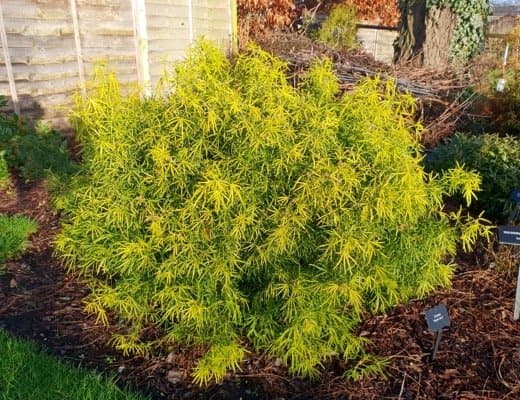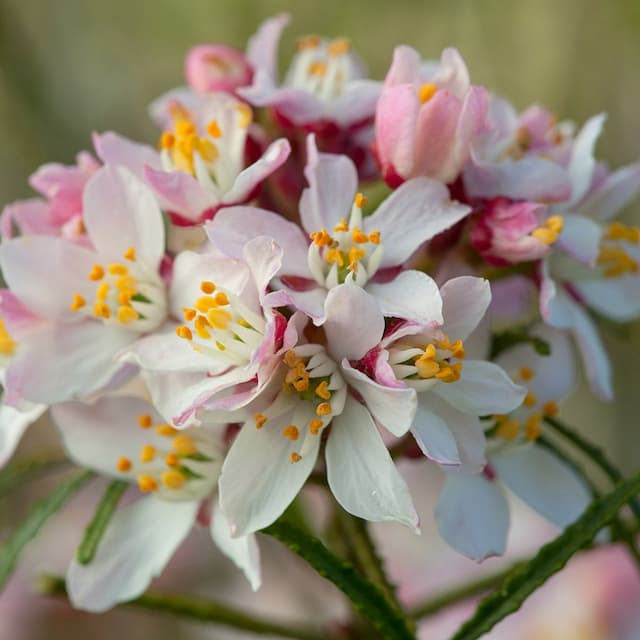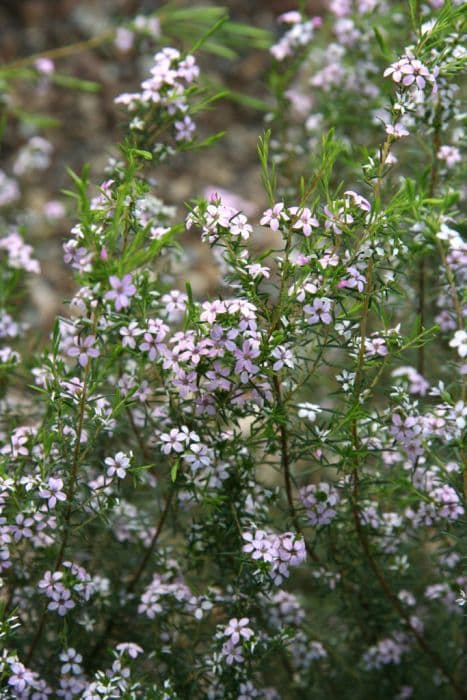Reeves Skimmia Skimmia japonica subsp. reevesiana

ABOUT
Skimmia japonica subsp. reevesiana, commonly known as Reeves Skimmia, is an evergreen shrub that is admired for its attractive appearance. It features a dense, bushy form with glossy, leathery leaves that are dark green in color. The foliage provides year-round interest, with leaves typically having a lance-shaped or elongated oval form, which gives the plant a lush, textural presence in the garden. During the spring season, Reeves Skimmia is adorned with clusters of small, fragrant flowers. The blossoms are typically white or light pink, and they appear in tight bunches, contrasting nicely against the dark green leaves. The flowers have a sweet, pleasant fragrance that can attract pollinators such as bees to the garden. Following the bloom period and depending on the presence of pollination, the plant may produce bright red berries which persist into the winter months. The berries, typically about the size of a pea, add a burst of color to the otherwise green plant and can provide visual interest as well as a food source for birds during the colder season. These ornamental features make Reeves Skimmia a popular choice for gardeners looking to add multi-seasonal appeal to their landscapes.
About this plant
 Names
NamesSynonyms
Reeves' Skimmia, Japanese Skimmia
Common names
Skimmia reevesiana, Skimmia japonica var. reevesiana.
 Toxicity
ToxicityTo humans
Skimmia, the common name for Skimmia japonica subsp. reevesiana, contains compounds that are toxic to humans. If ingested, it can cause various symptoms such as vomiting, diarrhea, and headache. In severe cases, ingestion could potentially lead to more serious consequences like respiratory difficulties. It is therefore advisable to avoid consuming any part of the Skimmia plant.
To pets
Skimmia is also toxic to pets. Ingesting parts of this plant can lead to symptoms including vomiting, diarrhea, weakness, and abdominal pain in animals such as cats and dogs. In severe instances, ingestion can even cause more serious issues like heart problems or seizures. Therefore, it is important to prevent pets from ingesting any part of the Skimmia plant.
 Characteristics
CharacteristicsLife cycle
Perennials
Foliage type
Evergreen
Color of leaves
Green
Flower color
White
Height
3 feet (0.91 meters)
Spread
3 feet (0.91 meters)
Plant type
Shrub
Hardiness zones
7
Native area
China
Benefits
 General Benefits
General Benefits- Aesthetic Appeal: Skimmia japonica subsp. reevesiana, commonly known as Reeves skimmia, has glossy evergreen leaves and produces attractive red berries and white flowers that enhance garden beauty year-round.
- Low Maintenance: Reeves skimmia is known for being a low-maintenance plant, requiring minimal pruning and care once established.
- Shade Tolerance: It thrives in partial to full shade, making it an ideal choice for shaded gardens where other plants might struggle.
- Drought Resistance: Once established, it is relatively drought-resistant, reducing the need for frequent watering.
- Wildlife Habitat: The flowers provide nectar for pollinators such as bees, while the berries can be a food source for birds during the winter months.
- Container Gardening: Due to its compact size, it is suitable for container gardening, allowing it to be placed on patios or balconies.
- Border Planting: It can be used as an effective border or edging plant, due to its neat, bushy habit and year-round interest.
- Deer Resistance: Reeves skimmia is generally resistant to deer, making it a good choice for gardens in areas with high deer populations.
 Medical Properties
Medical PropertiesThis plant is not used for medical purposes.
 Air-purifying Qualities
Air-purifying QualitiesThis plant is not specifically known for air purifying qualities.
 Other Uses
Other Uses- Decorative topiary or bonsai: With its dense foliage and slow growth, Skimmia can be pruned and trained into various topiary shapes or used as a bonsai specimen.
- Creating natural dyes: The berries of Skimmia can be used to extract natural dyes for coloring fabrics or crafts.
- Winter garden interest: Skimmia's evergreen leaves, red berries, and fragrant flowers in spring add visual interest and a splash of color to winter gardens when other plants are dormant.
- Container gardening: As a compact shrub, Skimmia is suitable for potting in containers, allowing for garden aesthetics in smaller spaces like patios or balconies.
- Floral arrangements: The foliage, flowers, or berries of Skimmia are often used in floral arrangements to add texture and variety, especially in winter-themed bouquets.
- Attracting wildlife: The berries provide a food source for birds during the winter months when food is scarce, helping to attract and support local wildlife.
- Living boundary: When planted in groups or rows, Skimmia can function as a living, decorative boundary or low hedge in gardens.
- Theme gardens: Skimmia fits well into Japanese or Asian-themed gardens due to its origin and aesthetic form, contributing to an authentic feel.
- Shade gardening: Skimmia thrives in shaded areas where other plants might struggle, making it an excellent choice for underplanting in forested or shaded gardens.
- Groundcover: Though not a traditional groundcover, low-growing varieties of Skimmia can be used to cover bare spots in shady areas of the garden.
Interesting Facts
 Feng Shui
Feng ShuiThe Skimmia is not used in Feng Shui practice.
 Zodiac Sign Compitability
Zodiac Sign CompitabilityThe Skimmia is not used in astrology practice.
 Plant Symbolism
Plant Symbolism- Protection: Skimmia, often used in gardens and landscaping, is believed to symbolize protection due to its robust nature and evergreen leaves, which persist through all seasons, offering a constant shield.
- Everlasting Life: As an evergreen plant, Skimmia represents immortality and eternal life, symbolizing the enduring aspect of the soul.
- Peace and Tranquility: The dense foliage and the soothing green color of Skimmia are often associated with calmness and peace, making it a common plant in gardens designed for relaxation.
 Water
WaterReeves Skimmia should be watered deeply to soak the root zone, then allowed to dry out slightly before watering again. During the growing season, water approximately once a week, providing about 1 inch of water each time, which is roughly 0.6 gallons for a medium-sized plant. In winter, reduce watering to every other week or less, depending on soil moisture levels. Overwatering can lead to root rot, so ensure good drainage and check the soil before adding more water.
 Light
LightReeves Skimmia thrives in partial shade to full shade. It is ideal to place the plant in a spot where it will be protected from the hot afternoon sun, such as under the canopy of larger trees or on the north side of a building. Filtered sunlight or a few hours of morning sun will help the plant to produce the best foliage and flower color.
 Temperature
TemperatureReeves Skimmia prefers cool to moderate temperatures and is hardy in USDA zones 6 through 9. It can generally handle temperatures as low as 0°F and as high as 80°F, but the ideal temperature range is 60°F to 75°F. Sudden temperature fluctuations and extreme heat can stress the plant.
 Pruning
PruningPrune Reeves Skimmia to maintain its shape and remove any dead or diseased wood. Light pruning should be done in spring after flowering to encourage bushiness. Major pruning is rarely necessary, but if needed, should be performed every other year to keep the plant rejuvenated.
 Cleaning
CleaningAs needed
 Soil
SoilReeves Skimmia thrives in acidic soil with a pH between 5.5 and 6.5. A mix of peat moss, pine bark, and perlite would provide an optimal blend for drainage and fertility. Keep the soil consistently moist but well-drained.
 Repotting
RepottingRepot Reeves Skimmia every 2 to 3 years, preferably in spring just before the growing season begins, using acidic soil mix to maintain health and vigor.
 Humidity & Misting
Humidity & MistingReeves Skimmia prefers moderate humidity levels. Attempting to maintain an environment with humidity around 50-60% is ideal for the well-being of the plant.
 Suitable locations
Suitable locationsIndoor
Provide bright, indirect light and ensure high humidity.
Outdoor
Plant in dappled shade with moist, well-draining soil.
Hardiness zone
7-9 USDA
 Life cycle
Life cycleSkimmia japonica subsp. reevesiana, commonly known as Reeves skimmia, begins its life as a seed, which after a period of dormancy, typically germinates in spring when the temperature becomes suitable. The seedling emerges and develops into a juvenile plant, characterized by a period of vegetative growth where the plant focuses on establishing a strong root system and foliage. As the plant matures, it enters the adult phase, developing its distinctive leathery, dark green leaves and woody stems. Reeves skimmia is dioecious, meaning that individual plants are either male or female; flowering occurs in mature plants with the males producing small, fragrant white flowers and females, if pollinated, bearing red berries. The plant's reproductive stage can last for many years, with the ability to flower and produce seeds annually. Finally, like all perennials, Reeves skimmia has a senescence stage where older plants experience reduced growth and reproductive capability, eventually leading to death.
 Propogation
PropogationPropogation time
Early Spring
The most popular method of propagating Skimmia japonica subsp. reevesiana, commonly known as Skimmia, is through semi-hardwood cuttings. This process involves taking cuttings from the plant's current season's growth in late summer or early fall. Choose healthy stems with several leaves and cut them to a length of about 4 to 6 inches. The lower leaves should be removed, and the cut end may be dipped in rooting hormone for improved success. The prepared cutting should then be placed in well-draining potting medium and kept in a humid environment until roots develop. It typically takes a few weeks to a few months for the cuttings to root. After the establishment of a strong root system, the new Skimmia plants can be transplanted to their final location.









